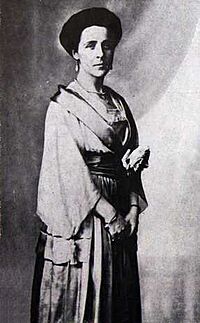Prince Bernhard of Lippe-Biesterfeld facts for kids
Quick facts for kids Bernhard of Lippe-Biesterfeld |
|||||
|---|---|---|---|---|---|
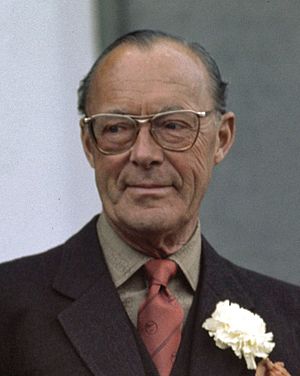
Prince Bernhard in 1976
|
|||||
| Prince consort of the Netherlands | |||||
| Tenure | 6 September 1948–30 April 1980 | ||||
| Born | Count Bernhard of Biesterfeld 29 June 1911 Jena, Saxe-Weimar-Eisenach, German Empire |
||||
| Died | 1 December 2004 (aged 93) University Medical Center Utrecht, Utrecht, Kingdom of the Netherlands |
||||
| Burial | 11 December 2004 Nieuwe Kerk, Delft, Netherlands |
||||
| Spouse |
|
||||
| Issue Detail |
|
||||
|
|||||
| House | Lippe-Biesterfeld | ||||
| Father | Prince Bernhard of Lippe | ||||
| Mother | Baroness Armgard von Sierstorpff-Cramm | ||||
| Religion |
|
||||
| Occupation | Military officer, aviator, conservationist, nonprofit director | ||||
| Signature |  |
||||
| Political party | Nazi Party (1933–1937) | ||||
Prince Bernhard of Lippe-Biesterfeld (born 29 June 1911 – died 1 December 2004) was a Dutch prince. He was the husband of Queen Juliana of the Netherlands. He served as Prince of the Netherlands from 1948 to 1980.
Prince Bernhard and Queen Juliana had four daughters. One of them was Beatrix, who later became Queen of the Netherlands. Bernhard was part of the German princely House of Lippe-Biesterfeld. He was known for his bravery during World War II. He also helped found the World Wildlife Fund (WWF).
Contents
Early Life and Education
Bernhard was born on June 29, 1911, in Jena, Germany. His full name was Bernhard Leopold Friedrich Eberhard Julius Kurt Karl Gottfried Peter. His parents were Prince Bernhard of Lippe and Baroness Armgard von Sierstorpff-Cramm.
At birth, he was called Count of Biesterfeld. In 1916, his uncle, Leopold IV, gave him and his mother the title of Prince and Princess of Lippe-Biesterfeld. This meant their family could inherit the throne.
After World War I, Bernhard's family lost their German principality. However, they were still well-off. Bernhard grew up at Reckenwalde palace in Poland. He was taught at home and later went to boarding schools in Züllichau and Berlin. He finished school in 1929.
As a boy, Bernhard was often sick. Doctors thought he might not live long. This might have made him take risks later in life. He was involved in several car and plane accidents.
Bernhard studied law at universities in Switzerland and Germany. He enjoyed fast cars, horse riding, and hunting. He survived a boating accident and a plane crash.
Prince Bernhard and World War II
While at university in Berlin in 1933, Bernhard joined the Nazi Party. His membership card was found after his death. He also joined the Sturmabteilung (SA), a Nazi group. He later said he joined to be able to take exams.
Bernhard left Berlin in 1934 and started working for IG Farben. This was a large German chemical company. He worked in their Paris office.
When Germany invaded the Netherlands in 1940, Prince Bernhard's feelings changed. He decided to fight against his birth country. He helped organize palace guards and shot at German warplanes.
The Dutch royal family had to leave the Netherlands. They went to England. Prince Bernhard wanted to stay and fight. But he agreed to join his wife, Princess Juliana, in London. His wife and daughters then moved to Canada for safety.
In England, Prince Bernhard wanted to work in British intelligence. King George VI helped him get involved. Bernhard worked with the Allied War Planning Councils.
He also became a pilot. He flew Spitfire planes with the Royal Air Force (RAF). He flew over occupied Europe, attacking enemy targets. He was awarded the Dutch Airman's Cross for his bravery. In 1941, he became an honorary wing commander in the RAF.
Prince Bernhard also helped organize the Dutch resistance movement. He worked as a personal secretary for Queen Wilhelmina. By 1944, he became Commander of the Dutch Armed Forces.
After the Netherlands was freed, he helped with the German surrender talks. He was seen as a true war hero by many Dutch people. After the war, he helped rebuild the Dutch economy.
Marriage and Family
Bernhard met Princess Juliana at the 1936 Winter Olympics. Juliana's mother, Queen Wilhelmina, was looking for a husband for Juliana. Bernhard was a Protestant prince, which made him a good choice.
Their engagement was announced in September 1936. They married in The Hague on January 7, 1937. Bernhard became a Dutch citizen and changed his name spelling to Dutch. He was given the title of Royal Highness.
Prince Bernhard and Queen Juliana had four daughters:
- Beatrix (born 1938), who became Queen of the Netherlands.
- Irene (born 1939).
- Margriet (born 1943).
- Christina (1947–2019).
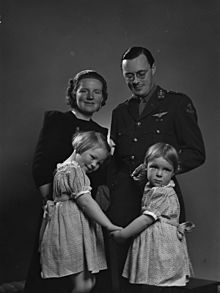
Post-War Contributions
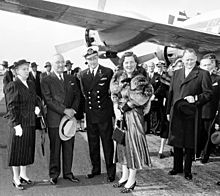
After the war, Prince Bernhard continued to serve the Netherlands. He became Inspector General. In 1948, his mother-in-law, Queen Wilhelmina, stepped down. Juliana became Queen, and Bernhard became the prince consort.
He joined the boards of companies like Fokker Aircraft and KLM Royal Dutch Airlines. He also became an advisor for many other organizations. He was seen as a great ambassador for the Netherlands in business.
Bilderberg Group
In 1951, a Polish diplomat named Józef Retinger suggested creating an international meeting. The idea was to improve relations between Europe and the United States. Prince Bernhard helped make this happen.
In May 1954, Bernhard was the organizer and chairman of the first meeting. It took place at the Bilderberg Hotel in the Netherlands. This meeting became known as the Bilderberg Group. Important people from business and politics met each year to discuss global issues. The idea for the European Union was also encouraged at these meetings.
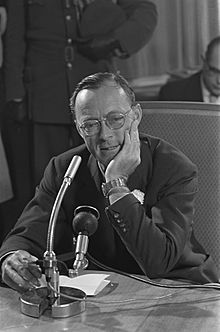
Prince Bernhard was very open about his opinions. He often spoke about things he cared deeply about. He always called for more recognition for Polish veterans of World War II. These veterans played a big part in freeing the Netherlands. After his death, the Dutch government officially recognized their role.
World Wildlife Fund
Prince Bernhard helped start the World Wildlife Fund (WWF). He was its first president from 1961 to 1976. The WWF works to protect nature and wildlife around the world.
To raise money for the WWF, he created the "1001 club" in 1970. This was a special club for members who helped raise a lot of money for the organization. He was also involved in creating many nature reserves. These included parks in Nepal, India, Poland, and Côte d'Ivoire.
International Connections
Prince Bernhard was known as a charming and well-connected person. He traveled a lot and had many friends in important places. He had his own airplane and loved flying. He also had a passion for cars and racing. He owned many Ferraris.
He spoke Dutch, German, French, English, and Spanish. He was friends with leaders like Nelson Mandela and David Rockefeller. He also knew Enzo Ferrari because of his love for cars.
Later Life and Passing
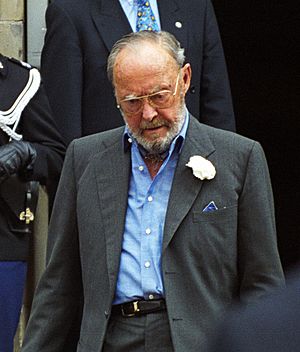
In 1994, Prince Bernhard had surgery for a tumor. He had some serious health problems afterward but recovered. His health continued to be a concern in the following years. He had prostate issues and breathing difficulties. However, he still attended his grandson's wedding after surgery.
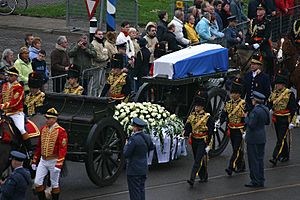
Prince Bernhard continued to attend military parades on Liberation Day. This day celebrates the defeat of Nazi Germany. When Queen Juliana passed away in March 2004, Bernhard became very frail. He managed to attend her funeral.
In November 2004, he was diagnosed with untreatable cancer. Prince Bernhard died at the age of 93 on December 1, 2004, in Utrecht. His state funeral was held ten days later in Delft.
His funeral had a military feel, as he wished. His coffin was carried on a cannon carriage. Many military marches were played. World War II veterans formed guards of honor. As a final tribute, F-16 jet fighters and a World War II Spitfire plane flew past in a special formation.
Titles and Honours
Titles
- 1911–1916: Count Bernhard of Biesterfeld
- 1916–1937: His Serene Highness Prince Bernhard of Lippe-Biesterfeld
- 1937–1948: His Royal Highness Prince Bernhard of the Netherlands, Prince of Lippe-Biesterfeld
- 1948–1980: His Royal Highness The Prince of the Netherlands
- 1980–2004: His Royal Highness Prince Bernhard of the Netherlands, Prince of Lippe-Biesterfeld
Military Ranks
Prince Bernhard held many military ranks in the Netherlands and as honorary foreign ranks.
Netherlands
|
|
|
| Rank | Date |  Air Chief Marshal Air Chief Marshal |
27 March 1953 |
|---|
Honorary Foreign Ranks
|
|
Ancestry
| Ancestors of Prince Bernhard of Lippe-Biesterfeld | |||||||||||||||||||||||||||||||||||||||||||||||||||||||||||||||||||||||||||||||||||||||||||||||||||||||||||||||||||||||||||||||||||||||||||||||||||||||||||||||||||||||||||||||||||||||||||||||||||||||||||||||||||||||||||||||||||||||||||||||||||||||||||||||||||||||||||||||||||||||||
|---|---|---|---|---|---|---|---|---|---|---|---|---|---|---|---|---|---|---|---|---|---|---|---|---|---|---|---|---|---|---|---|---|---|---|---|---|---|---|---|---|---|---|---|---|---|---|---|---|---|---|---|---|---|---|---|---|---|---|---|---|---|---|---|---|---|---|---|---|---|---|---|---|---|---|---|---|---|---|---|---|---|---|---|---|---|---|---|---|---|---|---|---|---|---|---|---|---|---|---|---|---|---|---|---|---|---|---|---|---|---|---|---|---|---|---|---|---|---|---|---|---|---|---|---|---|---|---|---|---|---|---|---|---|---|---|---|---|---|---|---|---|---|---|---|---|---|---|---|---|---|---|---|---|---|---|---|---|---|---|---|---|---|---|---|---|---|---|---|---|---|---|---|---|---|---|---|---|---|---|---|---|---|---|---|---|---|---|---|---|---|---|---|---|---|---|---|---|---|---|---|---|---|---|---|---|---|---|---|---|---|---|---|---|---|---|---|---|---|---|---|---|---|---|---|---|---|---|---|---|---|---|---|---|---|---|---|---|---|---|---|---|---|---|---|---|---|---|---|---|---|---|---|---|---|---|---|---|---|---|---|---|---|---|---|---|---|---|---|---|---|---|---|---|---|---|---|---|---|---|---|---|
|
|||||||||||||||||||||||||||||||||||||||||||||||||||||||||||||||||||||||||||||||||||||||||||||||||||||||||||||||||||||||||||||||||||||||||||||||||||||||||||||||||||||||||||||||||||||||||||||||||||||||||||||||||||||||||||||||||||||||||||||||||||||||||||||||||||||||||||||||||||||||||
Images for kids
See also
 In Spanish: Bernardo de Lippe-Biesterfeld para niños
In Spanish: Bernardo de Lippe-Biesterfeld para niños


